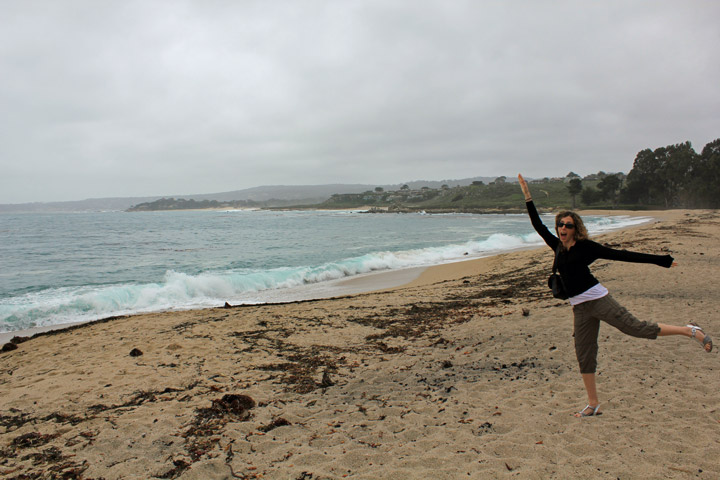Chris & Allyson vs. California (2014)
Day Four: The Winchester Mystery House. California 1. Seals at San Simeon.
San Francisco and Los Angeles are 400 miles apart, and you have your choice of ways to travel between them. Planes can get the job done, and Amtrak claims it's up to the task. Human trafficking rings can help you make that journey even faster and more comfortably than Amtrak.
We planned to drive, because it's the best way to see America. (In theory, riding in a chariot pulled by your defeated enemies is better, but we didn't bring our chariot, and we didn't have time to defeat the entire city of Oakland.) When life was simpler, people considered long drives to be vacations in and of themselves. You put your kids in a reasonably sized car, preferably with faux wood paneling, and showed them the country up close. They hated you in the moment, but 20 years later they appreciated the experience and chose to inflict it on their own kids. As many wise high school valedictorians have observed, the journey is what's really important.
You need to be well supplied for a journey, though, and some guy in Oakland now owned my jacket. Springtime in California can get a little nippy, so this was a problem. Fortunately, we were staying in the hottest, most high-end shopping district in San Francisco. All the finest retailers were within easy walking distance of our hotel.
Bypassing them completely, we went to Marshalls. They didn't have what we needed, so we grudgingly went up the retail ladder to a nearby Macy's. I bought two jackets -- I learned the hard way that you always want a backup in a secure location. Allyson bought new walking shoes to compensate for the horrible strain of vacationing the Chris White way.
After that, we were ready to follow in the footsteps of countless young dreamers with a song in their heart and the willingness to go topless if it meant finding work. We were going to HOLLYWOOD!
The first part of that journey involves driving down a bleak freeway to San Jose. As many wise high school valedictorians have observed, the journey is what's important, but sometimes it can also totally suck. However, you can always recharge your spirits with actual spirits. A little bit before noon, we pulled up to the Winchester Mystery House. Story time:

The Winchester Mystery House, a very cool place to visit.
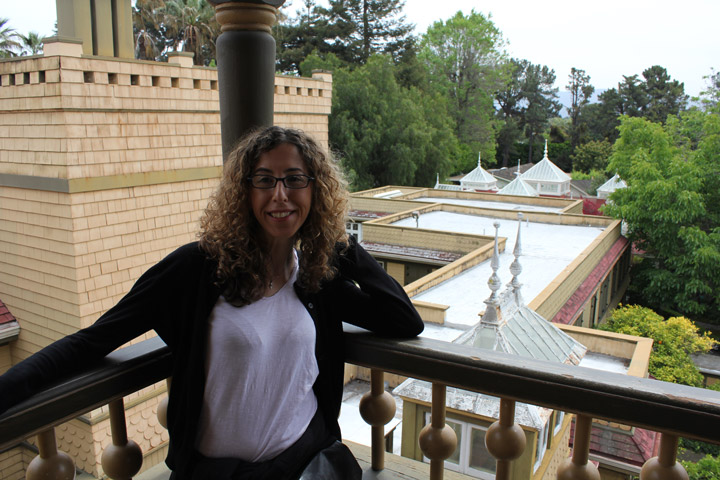
Sadly, no shots allowed inside, but shots on the balconies are OK.
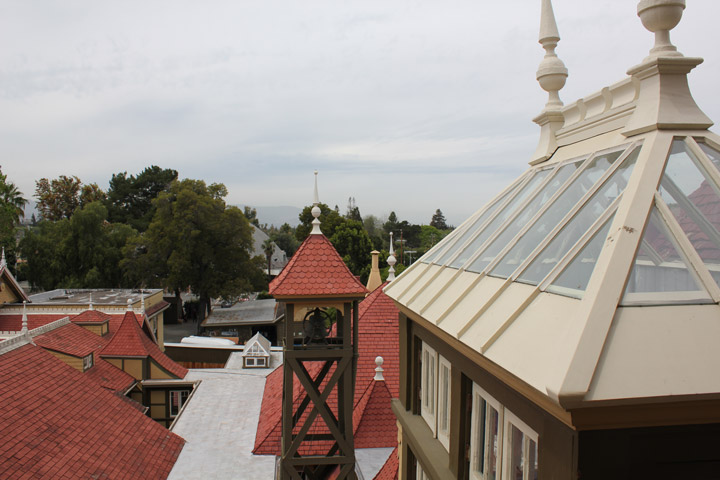
From above you get some sense of the very weird geometry.

Another look at the Mystery House exterior.
Sara Pardee was a society dame from Connecticut. In 1862, she married William Winchester, the heir to the Winchester rifle fortune. Lever-action Winchesters were fine weapons, allowing many settlers to kill Native Americans, grizzly bears and debt collectors with impunity. The happy couple had a lot of money.
But money couldn't buy you the cures to popular 19th century diseases. Sara and William saw their only child succumb to illness in 1866. Tuberculosis killed William in 1881. As the survivor, Sara was not in a good place mentally -- but she had a medium put her on the right track. The problem, clearly, was that the ghosts of everyone ever killed by a Winchester rifle were getting even with the family. Sara was advised to move west and start construction on a new home for the spirits. As long as she kept on building, the spirits would hold off on making her life a living hell.
This all seemed reasonable to Sara, who would politely be referred to as a character -- in that she was clearly in the grips of crippling depression, but she had a lot of money. She managed to be rational enough that no one could lock her up, and she was rich enough to surround herself with well-paid enablers.
So she bought an old farmhouse, surrounded by an orchard of fruit trees. She had no friends or associates in San Jose, and she wasn't interested in making any; she did bring a niece along as a live-in secretary, but her life was a little bit solitary. She paid servants and contractors well above prevailing wages, with the condition that no one could ever question her orders. And her orders were received each night, in séances where she received building plans directly from angry ghosts.
The ghosts were a little bit eccentric. Sara expanded her home -- after 38 years, it had 160 rooms. She also remodeled each of those rooms dozens of times, in ways that would make any 5-year-old with a Lego set proud. There are:
- 47 fireplaces, some of which vent inside the house
- 2,000 doors, including a few that open on brick walls and one that opens to a 10-foot drop to the carriageway
- 10,000 windows, including one in the floor of a room
- 40 stairways, including one that runs directly into a ceiling with no opening
- 6 kitchens
- 13 bathrooms but only one shower
- Supernatural flourishes, such as a private séance room that only Sara could enter
In terms of decorating, Sara had a thing for spider webs and the number 13; lots of the rooms have those themes repeated over and over again. She wasn't sentimental about what she built. By 1906, Sara had been focusing on one wing of the house for a few years. She was sleeping there when a huge earthquake caused structural damage and trapped her in a room for a day. She took it as a warning from the spirits that she was too close to completing that wing, so she promptly boarded it up and never set foot in there again.
It's all bonkers, in the best way possible. No one would ever build a home like this from scratch, and these days, people would be declared insane by their relatives before they could get two years into the project. The world is a less fun place than it used to be.
The standard tour takes you through most of the structurally sound parts of the house and includes lots of color about Sara. Afterward, you get to walk the very nice gardens. We both loved it. There's always something fun about a one-of-a-kind experience, and we had a nice conversation afterward about whether Sara was nuts. You can go either way. Clearly, she wasn't "normal," and people knew it -- when she died, all the workers promptly put down their tools and stopped building, because without her there was no reason to keep up the madness.
But she was lucid enough to keep the project going for almost four decades. She never bankrupted herself, and she didn't seem to let anyone take advantage of her. She fought off money-grubbing relatives, and the people who worked for her thought highly of her. In the end, the biggest impression we got was that Sara was profoundly sad. She had a huge safe in her house, and when people opened it after her death they found another safe inside, and a third safe inside that. It contained the obituaries of her husband and child, and locks of their hair.
With that cheery story warming our hearts, we were back on the way to Hollywood, via the cherry and garlic fields of Gilroy -- two great tastes that taste great together. We drove through Monterey, choosing to skip the canneries and economic desolation that you read so much about.
And right around there, the road became our next destination. It had long been a dream of mine to drive California 1 -- it's a great American experience, right up there with beating an eagle in an apple-pie eating contest.
The coast-hugging portions of California 1 were started in earnest in the 1930s, probably as a make-work project for all the laborers who had been struggling to find jobs since Sara Winchester's death in 1922. With mountains running straight up to the water in many places, the engineering would be a beast. There would have to be a lot of blasting and bridge-building to make a curvy road that barely met reasonable safety standards. There were no huge population centers on long stretches of the coast that would remotely justify the investment.
They built it anyway, because this is AMERICA. And it's beautiful. We were driving south, with the ocean on our right. There's an overlook every few miles, giving amazing views of cliffs and rocks and surf. It's an up-and-down road, so it takes you past beaches where you can stop and stretch your legs. The road is great fun to drive -- there are stretches where you're a flimsy guard rail away from plummeting to your death, so you're pretty much invested the whole time.
It's not the fastest drive, and there are lots of episodes along the way. We stopped at a beach near Carmel, where Clint Eastwood used to be mayor. We passed through Big Sur, where dirty hippies like to camp. We ran into a nice Australian couple from Melbourne (Richmond supporters, in case you were wondering) driving the opposite direction, and talked with them for 10 minutes about what was on the way.

Heading toward San Simeon, you'll pass a dozen gorgeous beaches.

The not-so pacific waves of the Pacific.

The Pacific Coast Highway does not disappoint.
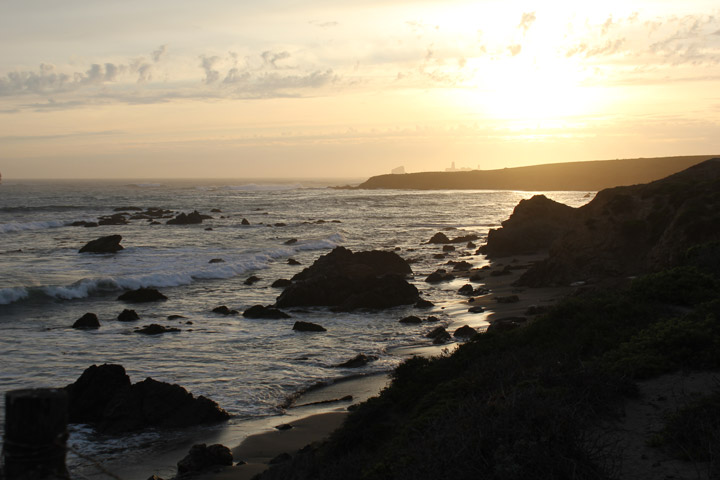
The sun was setting as we reached Piedras Blancas.
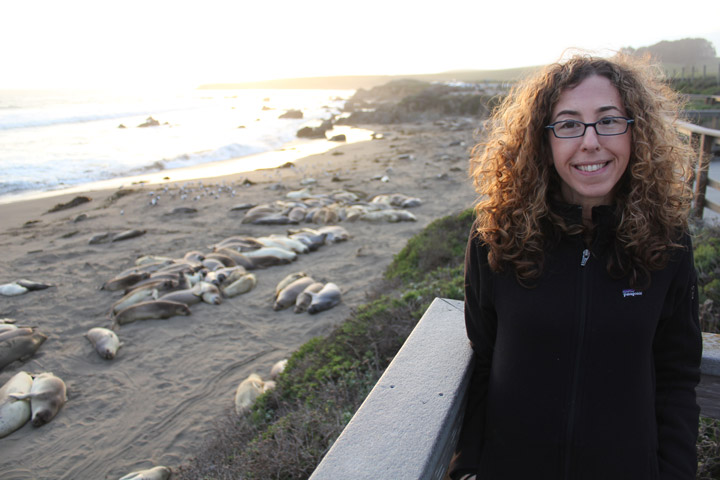
Happy to encounter more animal buddies: An elephant seal colony.
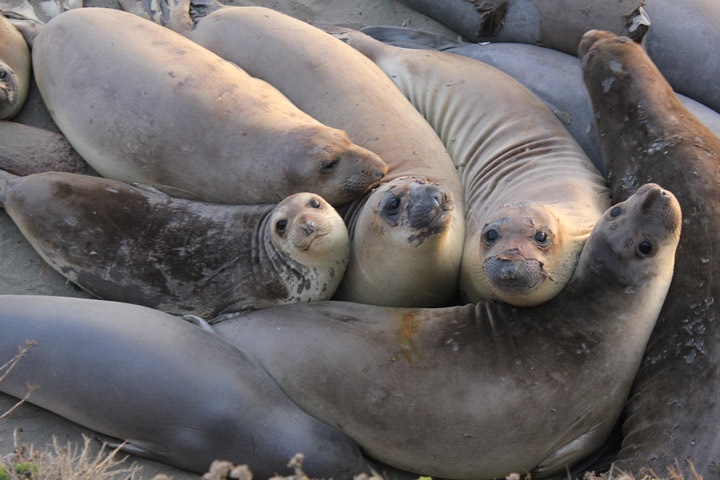
Elephant seals love the camera.
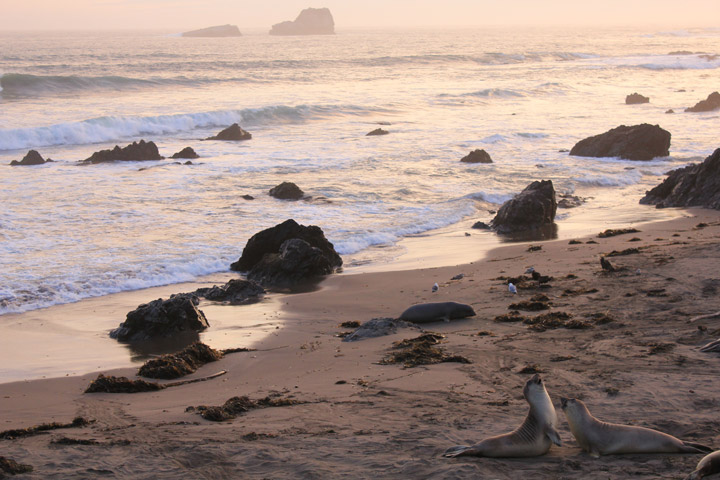
Two seals on the beach, either fighting or romancing. Same dif.
The best was saved for last. When you get close to San Simeon, the road straightens out -- you're cruising through low hills and a green coastal plain. The sun was getting low as we drove past the Piedras Blancas lighthouse, and a few minutes past that was the greatest road sign on the West Coast, pointing to the elephant seals.
Yes, a colony of seals makes its home on the beach at Piedras Blancas. They chow down in the ocean, then make their way back to the beach to sleep, make out, and lounge. The males are much bigger and uglier than the females, they all enjoy piling on top of each other, and from time to time they fight. They're basically the same as sea lions.
Even so, seeing the seals was a way cooler experience. The beach is closed to people -- the seals could easily rip your face off, if they felt the need -- but there are big observation decks on the dunes, putting you above your blubbery buddies. The time of day was perfect. It was what swimsuit photographers refer to as "the magic hour," when the setting sun gives everything on a beach, no matter how bloated and slimy, a warm glow. Even better, at that range you can hear the magic. A colony of elephant seals collectively makes a continuous stream of noises similar to a whinnying horse rolling through a field of whoopee cushions.
Also, we were there during molting season, so the seals all looked like that guy from "Dune."
Allyson had put in a long day -- it was my dream to drive the coast highway, and she won't be appreciating how much character it built for another 19 years or so. Also, when I'm driving, Allyson traditionally falls asleep within four minutes. We kept her awake by letting her choose the music from the fine selection of CDs we purchased in Haight-Ashbury. (Should you ever drive California 1, try it to the smooth sounds of Chromeo. It's what the Greatest Generation had in mind.)
The elephant seals were almost like Allyson's reward. From time to time I do things specifically to make my wife happy. Almost nothing that I have ever given or done has made her as happy as she looked watching those disgusting messes on the beach. I was OK with this, so our marriage is either in great shape or horrible shape. Either way, she gets some enjoyment out of fat mammals that make disgusting noises. So I plan on letting myself go, even more than I have already.
When the sun finally disappeared, we drove the last few miles to the San Simeon Lodge, where a reserved room was waiting. It was strategically chosen for its location -- we were going to Hearst Castle the next day, and the lodge advertises itself as the closest lodging to that attraction. It is, by about 200 feet.
But it's a solid motel, right out of the Americana handbook. We had a dinner with disturbingly huge portions at the attached restaurant, while listening to the smooth sounds of Muzak. You have not heard "Timber" by Kesha and Pitbull until you've heard the piano instrumental version. We then went shopping in the attached convenience store, where I bought a 24-ounce Modelo Especial. Then we relaxed in our very reasonably priced room, where Allyson watched a documentary, weirdly enough, on the building of the Bay Bridge. It should be noted that the cheapest hotel of our entire trip was also the one where the Wi-Fi worked best.
We were halfway to L.A., and we had already learned so much about ourselves along the way -- mainly, that we liked elephant seals more than sea lions, and that we would definitely consider using ghost architects if we ever build our own home. What a journey.
